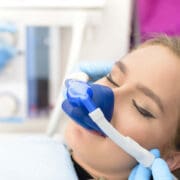Sedation Dentist: Relax and Stay Calm During Treatment
Have you ever wondered how a sedation dentist can help you relax and stay calm during dental treatment? By using various sedation techniques, a sedation dentist ensures that patients experience minimal anxiety and discomfort, making dental visits more pleasant and stress-free.
Sedation Dentist: Understanding Sedation in Dentistry
A sedation dentist plays a crucial role in helping patients manage anxiety and discomfort during dental procedures. Sedation in dentistry involves the use of medication to help patients relax, ensuring a more comfortable experience. This approach is particularly beneficial for individuals who have a fear of dental visits or those undergoing extensive treatments. By creating a calm environment, a sedation dentist can make dental care accessible to those who might otherwise avoid it.
Understanding the different levels of sedation is essential for anyone considering this option. From minimal sedation, where patients remain awake but relaxed, to deeper levels where they may not remember the procedure, sedation dentistry offers various options tailored to individual needs. For more detailed information on this topic, you can explore What Is Sedation Dentistry? Benefits and What to Expect.
Sedation Dentist
A calm dental visit can significantly enhance your overall experience at the dentist’s office. When you are relaxed, it allows the sedation dentist to perform procedures more efficiently and effectively, minimizing the time you spend in the chair. This tranquility can also reduce the perception of pain and discomfort, making the entire process smoother for both the patient and the dental professional. A stress-free environment contributes to better cooperation and communication, ensuring that your dental health needs are met with precision and care.
Moreover, a calm demeanor during dental visits can have lasting benefits on your mental well-being. It can help alleviate anxiety associated with future appointments, fostering a more positive attitude towards maintaining oral health. This positive experience can lead to more consistent dental check-ups, which are crucial for long-term oral health. For those interested in learning more about how a sedation dentist can facilitate a peaceful dental experience, visit our page on Sedation Dentistry in Rancho Mirage.
Types of Dental Sedation Explained
Understanding the different types of dental sedation can help alleviate anxiety and ensure a more comfortable experience during dental procedures. There are several common methods used to achieve sedation in dentistry, each tailored to meet varying levels of patient anxiety and procedural requirements. Nitrous oxide, often referred to as “laughing gas,” is a mild sedative inhaled through a mask, providing relaxation while keeping the patient awake. Oral sedation involves taking a prescribed medication prior to the appointment, resulting in a deeper state of calmness. For those requiring more significant sedation, intravenous (IV) sedation is administered directly into the bloodstream, allowing for a controlled and deeper level of sedation. Lastly, general anesthesia is used for more complex procedures, rendering the patient completely unconscious. Each type of sedation is carefully selected based on the patient’s needs and the complexity of the dental treatment, ensuring a stress-free and safe experience.
Overcoming Dental Anxiety Naturally
Dental anxiety is a common concern that can make visiting the dentist a daunting experience for many individuals. However, there are natural ways to help ease these feelings and create a more relaxed atmosphere during dental treatments. A sedation dentist can play a crucial role in helping patients feel at ease, allowing them to receive necessary care without the overwhelming stress that often accompanies dental visits. By focusing on creating a calming environment and understanding the unique needs of each patient, a sedation dentist can transform the dental experience into one that is more comfortable and less anxiety-inducing. For those seeking a compassionate approach to dental care, Cros Dental offers a welcoming environment as your trusted Rancho Mirage Dentist.
The Science Behind Sedation
Understanding the science behind sedation can help demystify the process and highlight why a sedation dentist is an essential part of modern dental care. Sedation works by using medications to help patients relax during dental procedures, targeting the central nervous system to induce a state of calmness and reduced awareness. This is particularly beneficial for those who experience anxiety or fear when visiting the dentist. The medications used in sedation dentistry can vary in strength, from mild sedatives that allow patients to remain awake but relaxed, to deeper sedation where patients are less aware of the procedure. By modulating the brain’s response to stress and discomfort, a sedation dentist can ensure that patients have a more comfortable and stress-free experience during their dental treatments.
Myths About Sedation Debunked
When it comes to visiting a sedation dentist, there are several myths that can cause unnecessary anxiety. One common misconception is that sedation dentistry is only for major procedures, when in fact, it can be used for a variety of dental treatments to help patients feel more at ease. Another myth is that sedation is unsafe, but in reality, it is a well-regulated practice with a strong safety record when administered by trained professionals. Some people also believe that sedation will make them completely unconscious, but most forms of sedation simply help patients relax while remaining responsive. Understanding these myths can help alleviate concerns and make the experience with a sedation dentist more comfortable.
Preparing for a Sedation Appointment
When planning a visit to a sedation dentist, it’s important to understand the process involved in preparing for your appointment. This preparation ensures that your experience is as comfortable and stress-free as possible. A sedation dentist will typically provide you with specific instructions to follow before your visit, which may include dietary guidelines or other preparatory steps. Understanding these instructions can help alleviate any anxiety and ensure that the sedation process goes smoothly, allowing you to relax and stay calm during your dental treatment.
What to Expect with Sedation
When visiting a sedation dentist, patients can anticipate a calming and stress-free experience tailored to ease dental anxiety. Sedation dentistry involves the use of medication to help patients relax during dental procedures, ensuring comfort and tranquility. The process typically begins with a consultation where the dentist assesses the patient’s needs and medical history to determine the appropriate level of sedation. On the day of the appointment, patients can expect to feel at ease as the sedation takes effect, allowing them to remain calm and relaxed throughout the treatment. This approach not only helps in managing anxiety but also enables the dentist to perform procedures more efficiently, as patients are more cooperative and less likely to experience discomfort.
Post-Sedation Recovery Insights
After visiting a sedation dentist, understanding the recovery process is essential for a smooth transition back to daily activities. The effects of sedation can vary depending on the type and dosage used during the dental procedure. Patients may experience lingering drowsiness or grogginess, which is a normal part of the recovery phase. It’s important to allow time for the sedative to fully wear off, ensuring that you feel completely alert before resuming regular tasks. The sedation dentist will typically provide guidance on what to expect post-treatment, helping to ensure a comfortable and safe recovery experience.
Conclusion
Discover the benefits of a sedation dentist and ensure a calm dental experience; call 760-444-3202 or visit our Google Maps page for more information.









